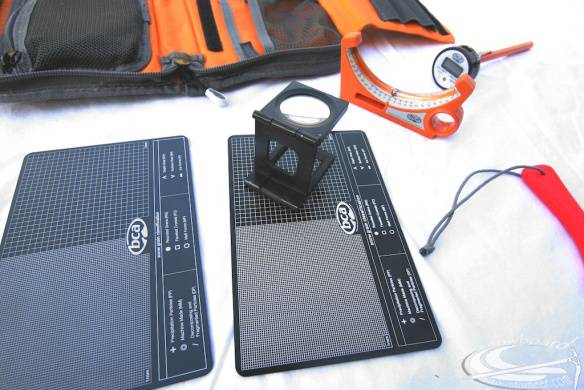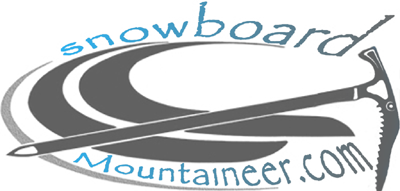Snow Study Kit [with some mods]
I have been asked numerous times why I carry certain items in a snow study kit, so I thought it would be time to revisit that. Our snow study kits go through seemingly endless modifications. I will share a few mods that have come in handy for snow study pits, at least for me.

For hasty snow pits to determine a rapid evaluation of snowpack we probably don’t need all that I am going to cover here. For formal snow pit profiles however, we probably carry a snow study kit containing some or all of the following; an analog or digital thermometer (or both), inclinometer, crystal card, loupe, probe, etc.
Note: I realize there are varying opinions on digital or analog thermometers. There is of course speculation as to which is better. Personally I prefer digital because it is more precise. The drawback of course is that it is electronic.
Recently I tore up a probe from the Rutschblock cord, so instead of enjoying a case of my favorite microbrew beer, I got to go buy a new probe. The problem with the G3 Rutschblock cord is the ferrules and springs are razor sharp (that’s great for slicing through snow), and gnaw up a pole or probe when used as a cutting guide in profile pits. I know many people use a piece of cordelette with knots tied in increments – sometimes with a nut or washer tied in the incremental knots. That works, sometimes, but it leaves a rough finish and becomes cumbersome when the cordelette freezes. I suppose this is due to the friction created around the probe, which then causes the snow to re-freeze on the cord. In Colorado, with our crust layers I have found the knotted rope to be ineffective at cutting through ice / crust layers. If it works for you, great. If not, I have a solution that will set you back the same amount of coin as cordelette.
I decided since no other type of Rutschblock cord exists (Brooks Range has the identical problem with their Rutschblock cord), I would fabricate my own. I used a 1/16″ coated stainless steel cable with #10-24 stainless steel nuts (for machine screws) spaced every 20cm (9″). I crushed the nuts on to the cable with a light tap of a hammer. More importantly though, I left a meter at each end so that the nuts do not come in contact with the probe. I used cable ferrules to place a glove loop at each end. You can find coated stainless cable at some hardware stores or online. I would emphasize the coated variety, or you will be buying a new probe after the cable cuts it.
I typically don’t do Rutschblock tests as much anymore. I prefer the Extended Column Test [ECT]. There are times when a Rutschblock test is necessary, but it is becoming an outdated form of stability test. I also use the Rutschblock cord as a cornice cutter (aka cornice bomb). I keep mine in a small nylon bag which can be filled with snow or weighed to toss over a cornice lip. The total length 7m, which is a meter longer than the standard, but the extra length comes in handy for cornices.
I know a lot of you use a snow probe for measurements in a profile. I am pretty anal about exact measurements because I use SnowPilot to graph out all snow study pits. I’m not saying probes are shooting from the hip, but “roughly 10cm” doesn’t cut it for me. I like precision. I pull temp gradients every 20cm and want to know exactly where fluctuations are occurring. For that I carry a BCA ruler. It’s light The force created by gravity acting on a mass." class="glossaryLink " target="_blank">weight, locks, and doesn’t bother me to carry.
Another ingredient in the snow study kit is a crystal card. I carry both an aluminum and Lexan crystal card. Temperature dictates which one I will use. Aluminum stays cold or super chilled, preserving crystals, but on warmer spring days the dendrite is a crystal that develops with a typical multi-branching tree-like form.
" class="glossaryLink " target="_blank">dendrites will melt quickly (especially on those warmer days where the air temp is above freezing). I have found the aluminum card to be better when looking at crystals on a planar sheer.. Either way, I always pre-chill either card away from the sun in the snow profile, but the Lexan crystal card works better in spring conditions because it isn’t as sensitive to the air temp.
I also carry a natural fiber 2″ brush for brushing layers in the profile. It is especially effective in brushing away hardness of F-4F< revealing layers more easily than wiping with a glove. I modified mine to fit in the snow study kit and eliminate unnecessary weight. As you can see, I also spray painted it high vis (pink is sexy!) – once you lose a few of these you will see why.
Another handy item for identifying layers is a spritz bottle with food color. I keep a small vial of food color in the snow study kit and mix it in the spray bottle with water on site. Lightly misting layers in a profile will reveal the crust layers and often hoar as a darker color.
Lastly, the snow saw for Extended Column Tests (ECT’s). There are a number of different snow saws available out there. Saws that connect to the pole or probe, avalanche shovel, etc. I opted for the BCA saw, partly because it is also designed to cut wood. The saw is 30cm which is the standard for Extended Column Test profiles. The down side is the cheap sheath that comes with it. You do not want to mess around with saw sheaths in the backcountry. These saws are typically razor sharp, more so than your typical wood saw. A flimsy sheath in the pack can make for an ‘unfun’ day if you are reaching in and forget. Likewise a snowsaw will make quick work of your avalanche pack. And, if you carry a airbag pack, well, let’s not even go there. I tossed the sheath that came with the saw and implemented a sheath made by Messermeister. These sheaths are designed for high-end chef’s knives, and they happen to make a 14″ low profile sheath for bread knives which fits the 30cm BCA snow saw. It fits perfectly and stays secure. You can find these online or specialty kitchen and knife shops. Update 8/26/14: Please see an update to a better snow saw sheath made from Kydex — here.
If you plan on doing on repeated snow profiles you might also want to think about the avalanche shovel you carry.
I apologize in advance if the guy I am referring to is out there reading this. But a few years ago I posted on a backcountry site for a partner to do the Dragontail Couloir with. When the guy showed up at the trailhead I noticed he had a garden variety plastic ‘avalanche’ shovel. I told him I would trade him shovels. When we got back to the trailhead later that afternoon he asked why I traded him shovels. I replied, “Because yours would have broken if you had to dig me out”.
I carry a Voile avalanche shovel. Anyone out there that has had to shovel avalanche debris would know why. If you don’t, go to an old avalanche slide path and try to shovel with the aluminum alloy shovels [or, if you are lucky you will get someone that shows up with a plastic shovel]. Avalanche debris in a continental snowpack is like shoveling concrete. Voile shovels are tempered steel, and for Colorado snowpack is the only thing I am comfortable with. The blade is also perfectly contoured for smoothing out snow profile pits.
Happy digging – be safe out there!













